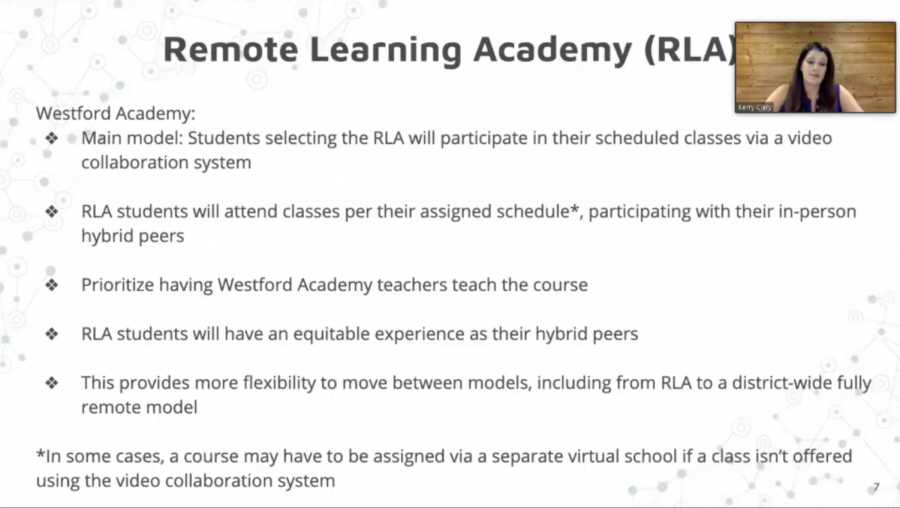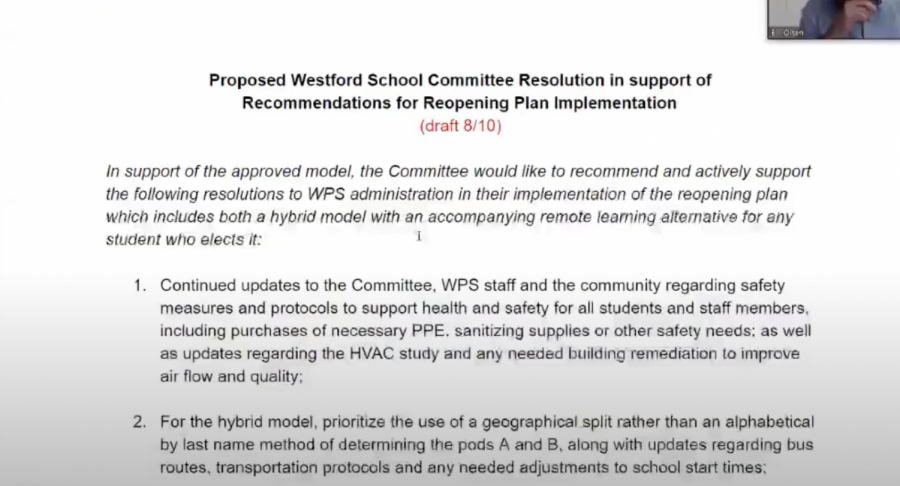School committee selects the hybrid model
August 11, 2020
The school committee made the decision on Monday, August 10, to implement a hybrid model with the option of a remote learning academy for the 2020-2021 school year. After last week’s meeting on Wednesday, August 5, the school committee still needed time to process the presented information. At this week’s meeting, the school committee heard the final proposals for special education learning, the hybrid model, remote learning. Ultimately, they voted in favor of the administration’s proposal.
Following further debate by the school committee on the proposal, it came time to finalize a vote. In total, four members of the committee voted for the hybrid model while three members, Alicia Mallon, Mingquan Zheng, and Valery Young, abstained.
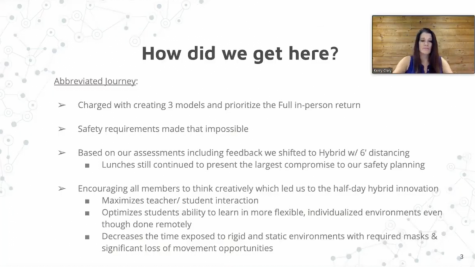
One of the concerns parents have with the hybrid model is the lack of a lunch period as well as physical movement throughout the day. Parents, specifically those of students at the elementary level, feel lunch and recess are integral parts of their children’s day. After hearing these concerns, Stony Brook Principal Dr. Christopher Chew and Abbott Elementary Principal Lori McDermott explained the reasoning behind no lunches.
“It sounds odd, but it is like the superintendent said, lunches are the biggest issue. We found that we just weren’t able to fit that in so we started looking into other options. It honestly came out of the wonderful creativity of the members of our committee. A number of people said we could hand out bagged lunches and the students could eat them at home. This way, we can keep social distancing rules while also providing meals to our community,” Dr. Chew said.
McDermott stressed that administration looked for ways to keep students in school for lunch, including eating six feet apart either in the gymnasium or outside. However, administration came to the conclusion that the time spent getting children situated for lunch would take away valuable learning time. According to McDermott, the Abbott Elementary tables, which could previously seat twenty-four students, can only seat two students with social distancing requirements.
“As far as teaching and learning goes, we have really tried to think outside of the box. I don’t want the public to think that we threw our hands up at lunch or think that we thought it would be a whole lot easier if we just didn’t serve lunch. We really have vetted this through for several hours to try and find a proactive way to make this plan work,” McDermott said.
Another one of the concerns is general safety. Superintendent Bill Olsen informed the school committee on the three goals administration had while putting together the plan: in-person instruction, minimizing the size of a cohort, and minimizing the size 0f assembling groups. According to Olsen, the hybrid model targets all of these goals and keeps students safe.
Olsen explained the rules everyone must follow while at school in order to accomplish maximum safety: no sharing materials, maintaining a distance of six feet in between each other, no in-school lunch, limited use of facilities, cleaning procedures based on the CDC’s recommendations, and the wearing of personal protection equipment.
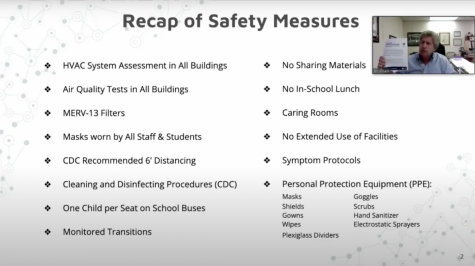
Additionally, buses will be cleaned after each run, and there will only be one student per seat. The students will take turns exiting the bus, maintaining a six feet distance.
Everyone is expected to wear a mask. Schools will provide shields for teachers who work in speech pathology and other areas in which students need to see the formation of words in order to grasp the concepts. Schools will also be providing faculty with protective glasses and goggles as an added safety measure.
Despite parent concern over the comfort and effectiveness of masks for kindergartners, Olsen highlighted that the only way to make sure everyone is safe is to mandate mask-wearing and a distance of six feet.
“Our approach is that all students and staff will wear masks because that has been shown to be the frontline of defense in terms of aerosolized moisture. We are also going with the CDC recommendation of six feet of distancing. We know that, in late June, the Commissioner of Education indicated that with appropriate. masking of students and staff, three feet of distancing would be acceptable. We don’t feel that’s the case in Westford. The CDC has indicated that close contact is determined by less than six feet of distancing for a period greater than fifteen minutes. So, if we were to have students three feet apart in classrooms, we would be putting students in a risk zone,” Olsen said.
For the hybrid model, Assistant Superintendent Kerry Clery detailed the elementary, middle, and high school set up.
The hybrid model will have half of the hybrid students attending in-person school during the half day hours. Once those students come back home for lunch, they will work remotely for two more hours. While the morning hybrid students are working remotely, the other half of the hybrid students will receive virtual lessons from their teachers. These halves, grouped in two pods, will switch off in-person schooling weekly.
In the elementary school model, one teacher will be in control of two pods, A and B. Pod A will meet with the teacher in the mornings for one week, while Pod B meets virtually with the teacher in the afternoon.
The middle school students will be grouped by team. The students who are in Pod A will attend school in the morning, while Pod B works remotely. In the afternoon, Pod B will work with teachers virtually, while Pod A works independently. Middle school teachers, just like in the elementary schools, will be moving around classrooms, limiting student travel throughout the day.
For high school, the only difference is students will leave the classrooms to travel to their next class. Based on the safety procedures Olsen presented, students will travel in one direction through the hallways, maintaining a proper distance from one another as per the guidelines.
The remote learning plan for elementary and middle school will involve students in the virtual lessons held in the afternoons. In the mornings, these students will work independently.
Clery expressed that the high school remote model will be slightly more complex than the remote learning models for elementary and middle school.
“Every child’s schedule is completely unique. Remote learning students disperse everywhere throughout the building, so you can’t just track them and keep them together the way you can with the cohort model at the middle and the elementary level. So, we are proposing a shift at the high school level. What we’re thinking is that students who select the remote learning option will participate in their scheduled classes, via a video collaboration system. So in this case, the school district would look to invest in the proper technology to allow students to participate in the classes that are happening live with their peers. We want to prioritize having Westford Academy teachers teach the courses that the students select,” Clery said.
For some classes, guidance may place students in an online course since those courses may not have a WA remote learning option. The DESE approved TECCA and Greenfield, online course platforms, as options for course enrollment.
“We do have partnerships at the state level with different organizations to allow us to have the students who are choosing the remote option sign up for a tech online academy. They’d still be under the Westford Public Schools enrollment umbrella… The Florida virtual school offers platforms and content, which is a different version of online, where we would have one of our teachers have a ready-made program. The Florida virtual school is best fit for our elementary schools, but I don’t see us using them,” Clery said.
Clery also mentioned that teachers can not decide whether they are returning in-person or staying at home remotely. As of right now, despite the Teachers’ Union taking the stance of a remote start to the year, teachers must be available to return to in-person school, unless they have a valid reason not to return.
Next, the meeting brought in Director of Pupil Services Courtney Moran, who talked about the plan for special education learning amidst the pandemic.
Moran explained how the special education department will aid students with disabilities. Over the past several weeks, the special education department looked into methods of teaching students with disabilities how to maintain social distancing requirements. Although it may be tough, Moran is confident that there are enough procedures in place to combat safety in special education learning.
“Now, we have stolen some great ideas from other daycares that have already opened. In fact, one of our student support leaders drops her child off at their daycare, and they have hula hoops that they use as their personal space. We can use this as our own form of PPE, so to speak, that we’ll be using with our youngest learners to try to get them to still be able to enjoy floor time by staying within their hoop. So, there are a lot of creative activity ideas [we have brainstormed],” Moran said.
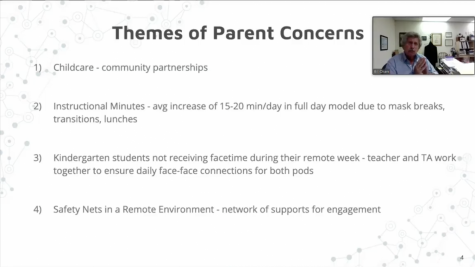
The proposal allows students in the special education program to either attend school in-person or virtually. The in-person special education schedule will follow the same hybrid model as the other classes, and the plan will give each student the chance to have some one-on-one time with a team.
The remote plan for special education provides one-on-one zoom calls, prerecorded academic videos, and other services to the student in special education.
“These are all acceptable means of delivering services, according to the Department of Education, and we will continue to do that. Other services that will continue are that we will be having team meetings for all of our students, whether their annual meetings or re-determining eligibility. We will also continue with all of our child find activities which include partnering with early intervention as well as our own IEP process in district,” Moran said.
Moran reiterated that the department will go to the greatest extent possible to give their students a smooth transition into the upcoming school year. If students require a re-evaluation for their special education position, staff will hold remote or in-person meetings. Parents will learn more about those meetings in the near future.
“So, unlike in the spring, when we knew that there were services that we just couldn’t deliver the Department of Ed is saying, deliver the services. And that’s really where we’re working hard to see how we’re going to do that with fidelity. It’s all the Department of Ed is also telling us to maximize, all of in person services to the best of our ability,” Moran said.
To conclude the meeting, after voting in favor of the hybrid model, the committee went over parts of their proposed resolution, which is in support of the hybrid model. School committee chair Gloria Miller took the lead in rewriting parts of the resolution. The school committee passed the resolution.
“This resolution is [the school committees] directive to administration in which it is our aspiration these considerations can be taken into account during the planning and implementation phase. We really are just trying to capture the totality of the discussion we’ve had over the last couple of weeks. [The school committee] plans on remaining engaged and actively supportive of administration as we move forward with these plans on it,” Miller said.
Link to full meeting: https://www.youtube.com/watch?v=EuMlWFWwEQk
